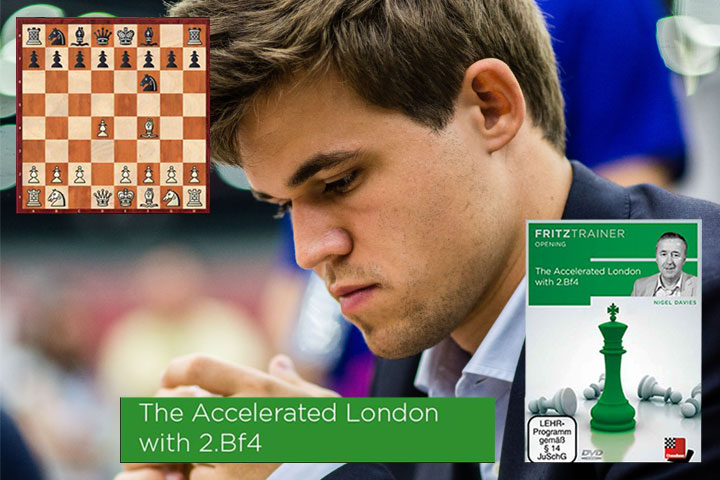A review
A week before the Georgia State Senior Championship, I already knew the list of players. Some were stronger than me — in the sense they were playing chess from 25+ years, while I began my chess journey around seven years ago. I cannot really outplay them in the opening. Their repertoire is quite solid, and made bullet-proof by its use in hundred of tournaments. Hence to overcome this problem, I made use of Lajos Portisch's wisdom well-summarized in the following quote:
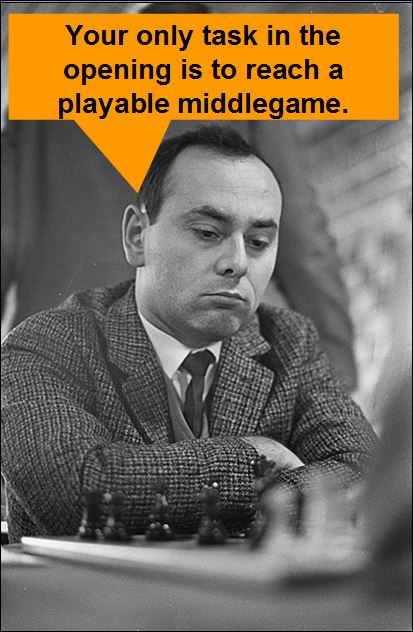
Portisch in Hoogoven 1968 | Photo: Ron Kroon / Anefo CC BY-SA 3.0 via Wikimedia Commons
Thanks to GM Nigel Davies I was able to find something which could bring me out of the opening and confront my opponent on the battlefield of ideas and imagination.
Davies begins by explaining the significance of playing 1.d4 Nf6 2.Bf4 on the second move compared to a move later:
 By playing the London System, with 1.d4 followed by 2.Nf3 and 3.Bf4, White can avoid a theoretical discussion and instead use natural ability plus a knowledge of plans. The weight of the struggle tends to shift towards the middlegame, but White can also pull off devastatingly quick wins should Black be unaware of the dangers.
By playing the London System, with 1.d4 followed by 2.Nf3 and 3.Bf4, White can avoid a theoretical discussion and instead use natural ability plus a knowledge of plans. The weight of the struggle tends to shift towards the middlegame, but White can also pull off devastatingly quick wins should Black be unaware of the dangers.
I believe these small points in the interpretation of the opening — even those based merely on adjustments in move orders which nevertheless reflect the struggle of the top players — are definitely fascinating.
When watching a video series, I make a note of the names of elite players mentioned. While the videos themselves are an excellent learning tool, that doesn't excuse us from doing our own homework. For example, Davies mentioned the "Grischuk move" after 1.d4 Nf6 2.Bf4 g6 3.Nc3 as in the following game:
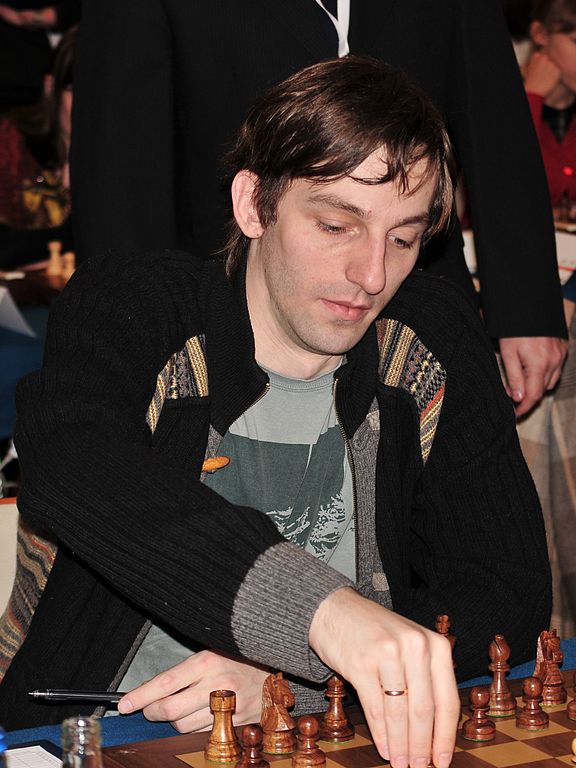
Grischuk in 2013 | Photo: Przemysław Jahr CC-BY-SA-3.0 via Wikimedia Commons
Not to nitpick but Prie and Ponomariov did use the Nc3 move before Grischuk. The first game in the database I have for Grischuk is dated 2014, while the former have games from 2010. Be that as it may, while we may hope to one day read an article on the historical evolution of the London System with the names of those who contributed to new ideas in the opening theory in the right order, that's not my focus here.
I provide some of their games, however, for your edification. As one can notice while reviewing these games there's a propensity to transpose into various other lines; some look like the Pirc/Modern; some could be transpositions into the Trompowsky, etc. The point is: watching the games can prepare us to be flexible, and switch to the right plan, depending on the pawn structure adopted by our opponents.
Don't miss the draw in Ponomariov vs Caruana, because it is quite exciting!
Moving on to the content of the DVD, the first video begins with a Stonewall formation reached after the moves: 1.d4 d5 2.Bf4 Nf6 3.e3 c5 4.c3 Nc6 5.Nd2 e6 6.Bd3 Bd6
A very similar structure is used by Black in the Dutch after the moves: 1.d4 f5 2.g3 Nf6 3.Bg2 e6 4.c4 d5 5.Nf3 c6 6. 0-0 Bd6
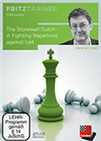 In the Dutch Stonewall Black from the very first move fights for the initiative. Let Erwin l'Ami take you on a fascinating journey to the depth and attractions of this unique opening. At the end you will be rewarded with a new repertoire against 1.d4!
In the Dutch Stonewall Black from the very first move fights for the initiative. Let Erwin l'Ami take you on a fascinating journey to the depth and attractions of this unique opening. At the end you will be rewarded with a new repertoire against 1.d4!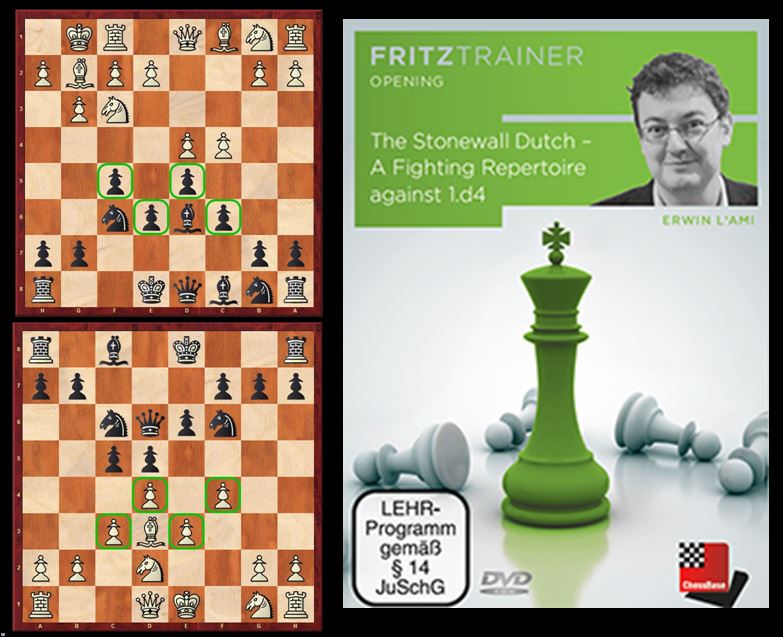
If you want to learn more about the Stonewall, GM L'Ami made a worthy DVD for Black
This brings me to an observation about learning openings: Some can be used from both sides, and it is more important to understand, say, what we should do with a certain central pawn structure, than trying to memorize the individual moves. I digress for the sake of thoroughness but the goal of the first video wasn't about teaching the Stonewall formation, but rather concerning what to do against Black's defensive plan based on Bd6. The idea is to exchange the dark squares bishops, and then at the right moment, push e6-e5. I think Davies treats the topic quite well.
Thanks to Davies skilful teaching, we discover transpositions into other openings as well. For example in video number four on the game Trent vs Haslinger, Davies shows the variation 1.d4 d5 2.Bf4 Nf6 3.e3 c5 4.c3 Nc6 5.Nd2 saying this is a line some club players could continue with: 5...cxd4 6.exd4 Bf5:
And then he mentions this line could arise from a Caro-Kann exchange, for instance, after the moves 1.e4 c6 2.d4 d5 3.exd5 cxd5 4.Bf4 Nc6 5.c3 Bf5. 6.Nd2.
Throughout the DVD, while showing different variations, Davies also explains the typical manoeuvres and plans one should follow as White. But he also explains Black's plans, like in the following diagrams:
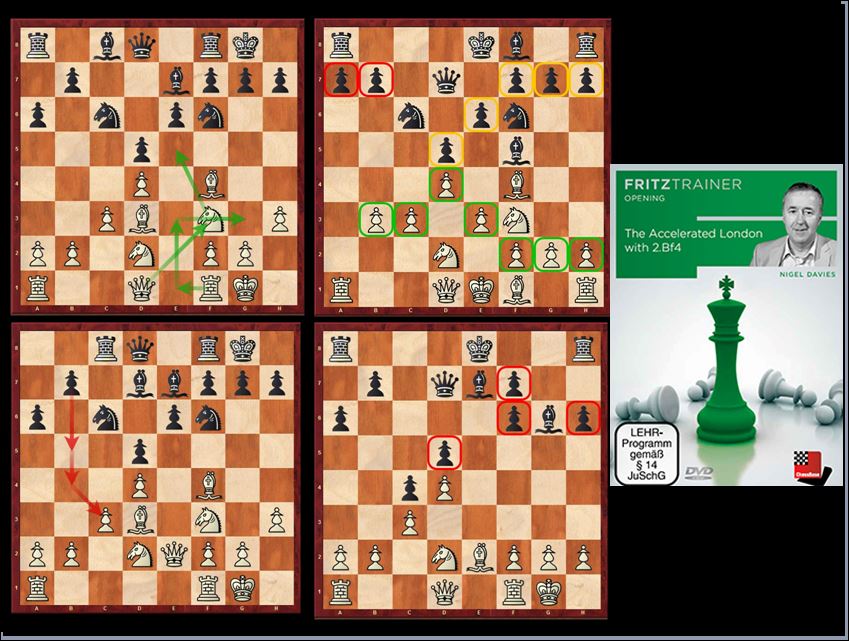
There are 24 videos which show and treat all the lines of the London System. Followed by ten videos with quiz positions. A database of 121 model games, and the database with the theoretical lines shown in the videos: 24 games/lines.
I'd like to say a word or two about the games in the database. Many start out with a Trompowsky, which then morphs into a London. I just began to use the Trompowsky myself, and seeing how the two systems can work together was quite eye-opening. It helped me to be familiar with the Trompowsky since often when we just begin to use a new opening we are scared to use it in tournament.
Often when a video is ending Davies offers two or three different plans for White. Since I don't think one can remember it all 10-15 days later, one way to manage is to create some flashcards, with the final position given by Davies, and the main plan. Eventually one can review the flashcards before a tournament until he manages to internalise the lines. Here's mine:

Before finishing the review, I'd like to share few games by the World Champion Magnus Carlsen, in which he steamrolls some of the best players in the world, thanks to the Accelerated London!
Scarcely any world champion has managed to captivate chess lovers to the extent Carlsen has. The enormously talented Norwegian hasn't been systematically trained within the structures of a major chess-playing nation such as Russia, the Ukraine or China.
Pro and Con
Davies says at the outset, "because it is so little known and there is little theory, it throws your opponent on his own resources." This, unfortunately, is no longer true. The London System has been used by Carlsen extensively, and the chess world has noticed. Things can be different at the amateur level, but when the World Champion uses an opening many times — which means his games have been thoroughly annotated — people take notice.
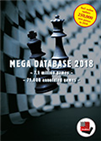 The "Mega" is the database every serious chessplayer needs. The database contains 7.1 million games from 1500 to 2017, in highest quality standard, full of top level analyses and completely classified.
The "Mega" is the database every serious chessplayer needs. The database contains 7.1 million games from 1500 to 2017, in highest quality standard, full of top level analyses and completely classified.In fact, a search in my Megabase 2018 yields about 20 games played by Carlsen with 1.d4 Nf6 2.Bf4, and for 1.d4 d5 2.Bf4 about 10, which is good news, because we can model our London repertoire using someone who is definitely the best of the best.
Davies is right about having openings nowadays go on for 20 or more moves of theory. However the truth is, in the tournaments where I play, even with players rated 2200-2300, they simply don't remember 20 moves of theory. This doesn't mean they will not play 20 moves of theory — they may, but they are not aware of them as theory. The proof is by the clock times which I write for each move on my scoresheet. When by move 5-6 my opponent is using 30 seconds or more for each move, that is definitely not theory for him.
I really like the way Davies takes advantage of the FritzTrainer system frm the start, e.g. by stopping the video and asking viewers to find the right move, preparing video feedback if one doesn't get it right.
I also believe in Davies teaching approach, introducing some lines just for the sake of explaining what White should do in some situations. It was a great way to gain insight into why we are do what we do. However, while praising Davies, I must warn the reader. Some evaluations, while are correct at Davies' level, may be difficult for club level players to grasp. To avoid surprises one needs to play many of the positions given by Davies against the engine or on play.chessbase.com to gain practical experience.
Final thoughts
Davies has made a hands-on DVD — even in the first video, he didn't show the moves but just began by showing the centre. Asking what to do if... I appreciated this learning style, because it's a bit like what happens in real games. We are thrown in the battle without much knowledge and we must find our way out. I feel prepared for the next tournament thanks to this DVD, and I think this is the maximum one can ask. He was also honest, since in many positions he didn't say White is better, he said one can try to create some problems, and showed how one should continue.
So, if you want to learn the London or just to become acquainted with this opening, Davies is a good way to go.
On this DVD Nigel Davies explores these fascinating plans which give the London System a lot of bite and offer scope for creativity.
Links
